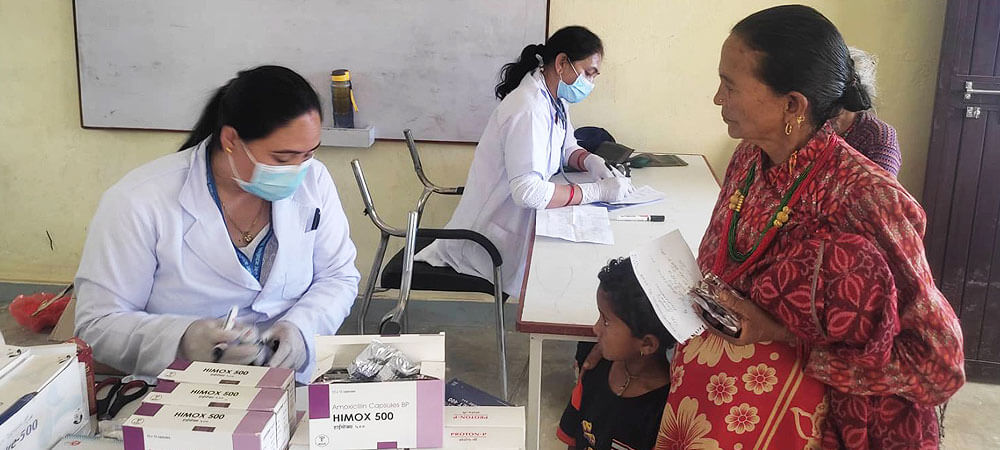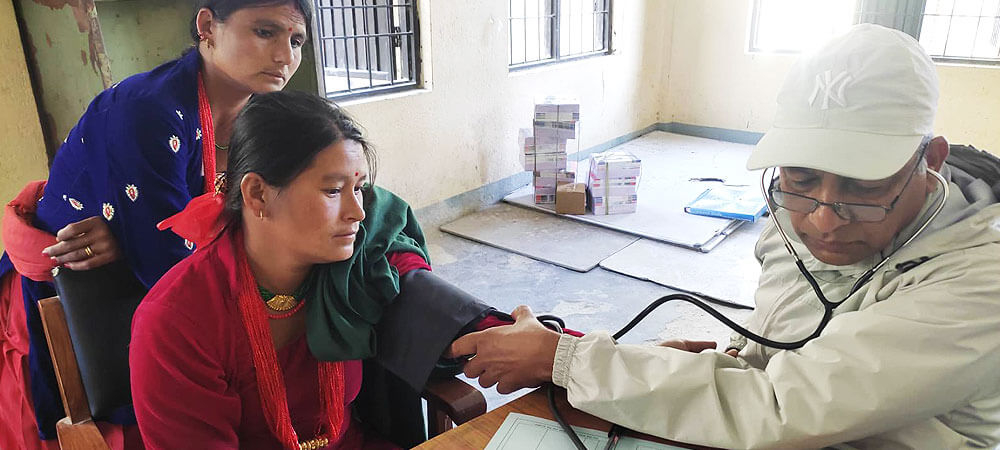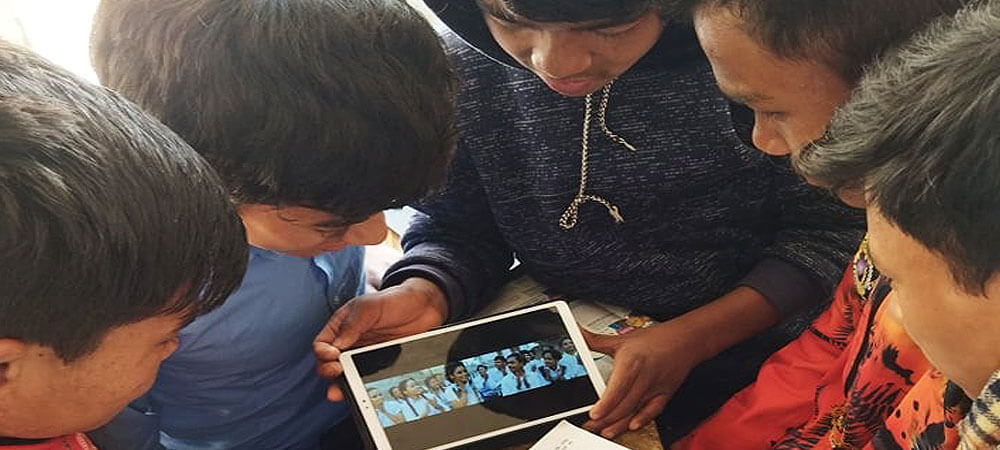LANGTANG RELIEF
INTRODUCTION
Rasuwa is one of the worst affected districts by the 25 April earthquake. As of 8 May, 430 people have been, reported killed and 753 injured Most of those that died in the district were killed in an avalanche that buried inhabitants of Langtang village including tourists in the guesthouses. Some remote areas are yet to be reached or accounted for. More than 63% of the district’s territory is at an elevation of more than 3000 meters. Of the remaining territory, most parts are located at an elevation between 1000 – 3000 meters and parts of Rasuwa were without road access even before the earthquake, further challenging the relief effort. In the first few days after the earthquake very little information was available from Rasuwa. Field reports have gradually come in that help understand thesituation. Initial estimates based on Government data of damaged buildings in the affected districts, suggests that 82% of the population of Rasuwa have been affected by the earthquake. According to Government data, 8,000 buildings were destroyed in the earthquake.
The displaced population has made their own temporary shelter using available materials, including materials from damaged houses, or is living under tarpaulins. There are reports of people sleeping outside even if their houses are still standing, due to fear of landslides. In Syaprubesi there are entire communities displaced with most of them living under plastic sheeting, some in tents without proper techniques for tying off or setting them up away from structurally compromised building. Living conditions are varied, in some places (such as Syaprubesi) they are described as crowded, with people staying together in clusters and with minimal protection against the elements while in ThuloSyapru village, there are plenty space. People are using tarpaulin and bamboo mat roofing Shelter priorities are tents, construction tools, and stronger materials to withstand the monsoon and winter.
Langtang is the third most-popular destination for trekkers in Nepal, after the Khumbu and the Annapurna regions. The spring season (March to May) is a popular hiking season near the valley. In the sparsely populated area, with a maximum of 2,500 people living in the main settlement of Langtang village, tourism is the main source of income of the people.
OBJECTIVES
- To provide essential post relief materials for livelihood.
A SITUATION OF LANGTANG
An analysis of the upper Langtang Valley suggests that air pressure waves, landslides, and avalanches destroyed much of the valley’s villages following the 25 April 2015 earthquake. Eyewitness accounts describe huge and fast-moving avalanche clouds, which were likely triggered when parts of the hanging glaciers in the Langtang Lirung and Langtang II Mountains dislodged and collided with the mountain. Evidence indicates that before the earthquake, debris and ice from previous ice avalanches and rock fall from Langtang Lirung had accumulated on the mountainside around an elevation of about 4500 metres above sea level. Water from small glacial ponds also possibly contributed to avalanche material. The avalanches consisted of snow, ice, and rock material, and accelerated down the steep valley, which displaced the air and created strong pressure waves. Photographs of the valley, taken by rescue helicopter pilots, show flattened trees stripped bare of their bark, suggesting winds of at least 150km/h. As a result, the valley’s eight highest villages were damaged or completely destroyed, and many lives were lost. Four of these villages, Tsarding, Chamki, Gumba, and a large part of Langtang – the main village of the valley – were also covered by a long runout landslide, which damaged these villages beyond recognition. The newer, western part of Langtang village is covered by a mass of debris and ice. The foundations of the houses in the older, eastern part of Langtang village are still clearly visible in a photograph taken after the event, and suggest that this part of the village was affected by the pressure wave, but not covered by the landslide. Only two buildings in Langtang were not damaged beyond recognition: the new health post above the village, and a house built very close to a high rock wall in the north of the village. In Thyangshyup, the pressure wave destroyed all houses. In Kyangjing, Singdum, and Mundu, the pressure wave substantially damaged the houses. People in Kyangjing reported flying tin roofs, broken wood, and rocks, which turned into dangerous projectiles. In Singdum and Mundu, many houses were damaged, but inhabitants remained mostly safe. This is presumably because unstable ice had broken off the hanging glaciers above these villages a few weeks before the earthquake, thus clearing the glacier of some of the unstable ice. Eyewitness reports and satellite imaging indicate that some avalanche or landslide activity continued after the earthquake’s primary shock. It must be expected that more mass movements will take place, as they are already common even without earthquake tremors.
A strong sense of community and help from outside assists survivors to rebuild their homes and lives.
TARGET AREAS AND NECESSITIES
Langtang Ri Trekking and Expedition has been working associating with HOMES Nepal for disaster management and providing relief materials, post relief materials and construction materials for the most affected places of the Gorkha, Nuwakot, Sindhupalchok, Rasuwa and Kathmandu. We cover the areas of Ghodatabela, Lama hotel and Kyangjin where more than 800 people had been living before earthquake and 200 hundred lives were lost by the devastating earthquake and its aftershocks. All houses are damaged and rests of 600 hundred around 117 families are living under the temporary shelters. It is the shaded areas of government and other donors agencies and hard to reach the living materials for them. Their main source of income is tourism. Langtang trekking has been closed due to bad land slide and all the trekking routes are blocked. In this situation, the dwellings of these areas are living under the severe food crisis and other necessary materials.
We cover the areas of Ghodatabela, Lama hotel and Kyangjin where more than 800 people had been living before earthquake and 200 hundred lives were lost by the devastating earthquake and its aftershocks. All houses are damaged and rests of 600 hundred around 117 families are living under the temporary shelters. It is the shaded areas of government and other donors agencies and hard to reach the living materials for them. Their main source of income is tourism. Langtang trekking has been closed due to bad land slide and all the trekking routes are blocked. In this situation, the dwellings of these areas are living under the severe food crisis and other necessary materials.
It was reported that the survivors were preyed upon by human traffickers involved in supply of girls and women to the brothels of South Asia. It was like the worst nightmare phase for the people of Nepal who were in a state of fear. The most affected were the poor communities who lost their homes.
BUDGET
| Budget for Necessary Materials | |||||||
| For one Family | |||||||
| SN | Materials | Unit | Kg/Pcs | Rate/Kg/Pcs | Amount (Rs) | Total Kg | USD $ |
| 1 | Rice | KG | 30 | 60 | 1800 | 30 | 18 |
| 2 | Lentil (Dal) | KG | 10 | 150 | 1500 | 10 | 15 |
| 3 | Floor (Pitho) | KG | 10 | 40 | 400 | 10 | 4 |
| 4 | Salt | KG | 5 | 30 | 150 | 5 | 1.5 |
| 5 | Cooking Oil | ltr | 10 | 300 | 3000 | 10 | 30 |
| 6 | Sugar | KG | 10 | 80 | 800 | 10 | 8 |
| 7 | Tea | KG | 2 | 400 | 800 | 2 | 8 |
| 8 | Blanket | Pcs/4kg each | 2 | 4000 | 8000 | 8 | 80 |
| 9 | Cereals | KG | 10 | 250 | 2500 | 10 | 25 |
| 10 | Soap Bathing | Pcs/100gm | 10 | 30 | 300 | 1 | 3 |
| 11 | Soap Washing | Pcs/200gm | 10 | 20 | 200 | 2 | 2 |
| 12 | Tooth paste | Pcs/200gm | 2 | 150 | 300 | 0.4 | 3 |
| 13 | Tooth Brush | Pcs/20gm | 5 | 30 | 150 | 0.1 | 1.5 |
| 14 | Medicines | LS/500gm | 1 | 500 | 500 | 0.5 | 5 |
| 15 | Woolen Cap | Pcs/200gm | 1 | 300 | 300 | 0.2 | 3 |
| Total | 20700 | 99.2 | 207 | ||||
| A | For 117 Families | 2421900 | 11606.4 | 24219 | |||
| Transportation Cost | |||
| Kathmandu - Syapru | |||
| Total Kg | 11606.4 | ||
| Rate Per Kg | 10 | ||
| Total Amount | 116064 | ||
| Syapru to Langtang Area | |||
| Total Kg | 11606.4 | ||
| Khachar | 232.128 | 1 khachar = 50 kg | |
| No of days | 6 | ||
| Rate/Khachar | 1000 | ||
| Total Cost | 1392768 | ||
| B. Total Transportation Cost (Rs) | 1508832 | ||
| USD $ | 15088.32 | ||
| Total Budget (A+B) | 3814668 | USD $38146.68 | |


















